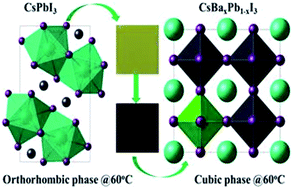A thermally stable, barium-stabilized α-CsPbI3 perovskite for optoelectronic devices†
Abstract
The all-inorganic perovskite CsPbI3 has emerged as an alternative photovoltaic material to organic–inorganic hybrid perovskites due to its non-volatile composition and comparable photovoltaic performance. However, its spontaneous deformation from the light-active black phase to a light-inactive yellow phase under ambient conditions, poor air stability, low thermal stability as well as high-temperature processing are challenging issues in the fabrication of CsPbI3-based solar cells. Herein, we introduce a new surface passivation strategy using camphor sulfonic acid (CSA) to improve the surface morphology and air stability of Ba-stabilized α-CsPbI3 perovskites at low temperature. The surface passivated, Ba-doped α-CsPbI3 was thermally stable upon annealing and highly photo-stable over a year, and it also exhibited a band gap of ∼1.72 eV, which is suitable for optoelectronic applications. The all-inorganic solar cell based on the Ba-doped α-CsPbI3 retained 98% of its initial PCE value even after 700 h, and red light-emitting diodes (LED) exhibited light emission at 700 nm with a bandwidth of 39 nm. To date, this is the first study on surface passivated, Ba-stabilized α-CsPbI3, which provides opportunities for the development of highly efficient tandem solar cells and other optoelectronic devices.



 Please wait while we load your content...
Please wait while we load your content...